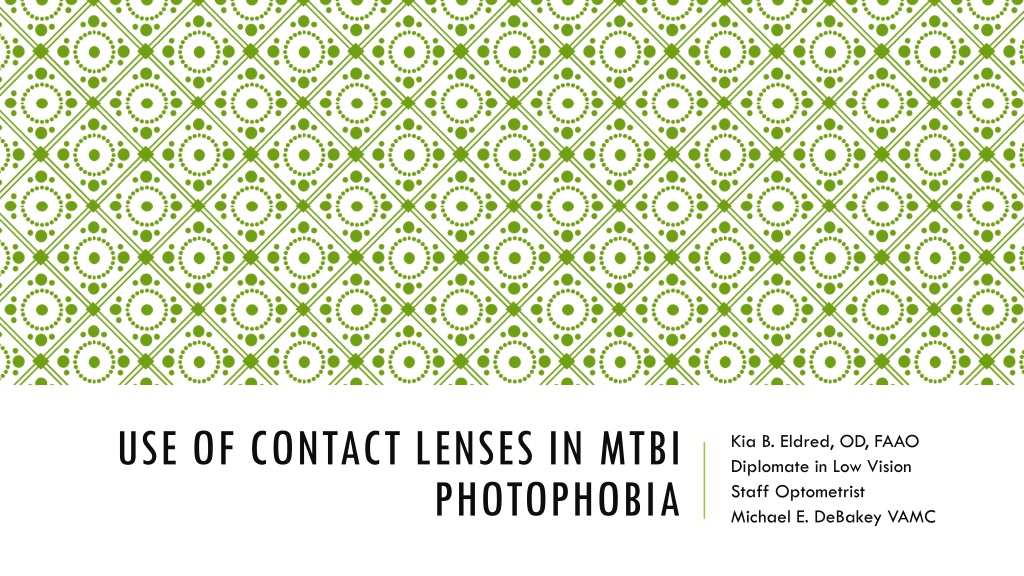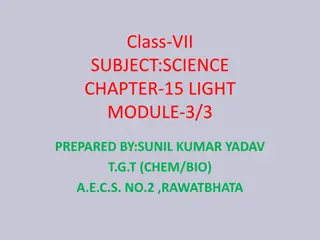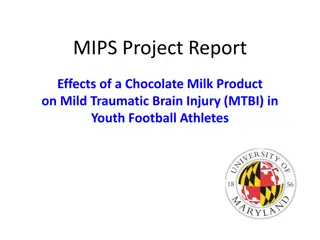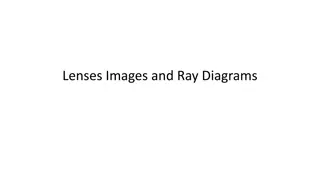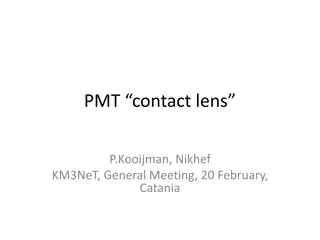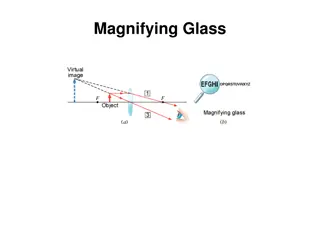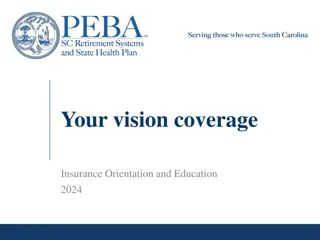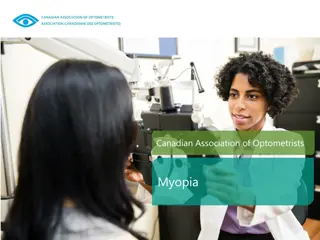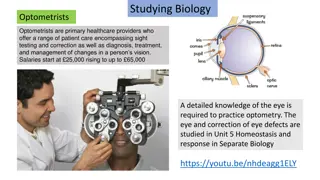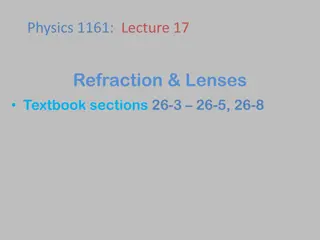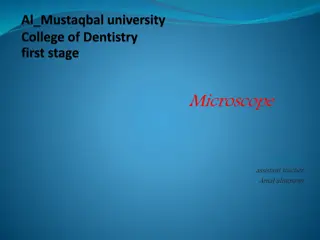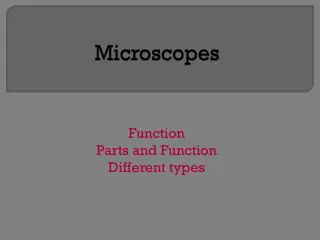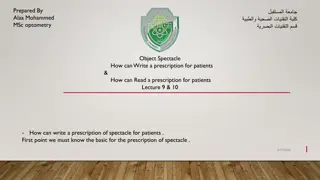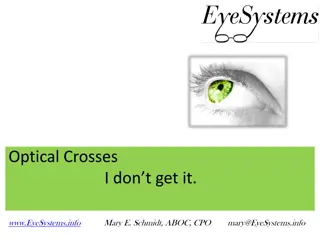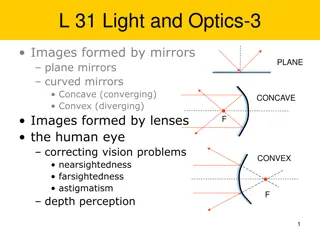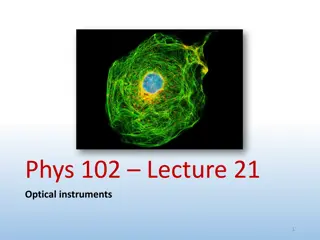Understanding the Use of Contact Lenses in Photophobia Associated with mTBI
Photophobia in patients with mild traumatic brain injury (mTBI) can be debilitating, with up to 59% of military personnel reporting sensitivity to light after a TBI event. Contact lenses, sunfilters, and tinted glasses can help manage photophobia symptoms. Mechanisms underlying photophobia involve the thalamus, trigeminal system, and retinal ganglion cells. Effective management strategies include blocking blue light, using FL-41 tints, and avoiding bright light sources to alleviate discomfort and pain associated with photophobia.
Download Presentation

Please find below an Image/Link to download the presentation.
The content on the website is provided AS IS for your information and personal use only. It may not be sold, licensed, or shared on other websites without obtaining consent from the author. Download presentation by click this link. If you encounter any issues during the download, it is possible that the publisher has removed the file from their server.
E N D
Presentation Transcript
USE OF CONTACT LENSES IN MTBI Kia B. Eldred, OD, FAAO Diplomate in Low Vision Staff Optometrist Michael E. DeBakey VAMC PHOTOPHOBIA
MECHANISM OF PHOTOPHOBIA Photophobia is a misnomer it means fear of the light. It denotes patients who have an abnormal sensitivity to light. Photo-oculodynia refers to a non-painful light source producing pain in the eye. Migraine is associated with photophobia, just having the symptom predicts the individual has underlying migraine. (Muellerners et al) Kathleen Digre, MD notes blocking blue light may be most soothing, also use of FL-41 (rose color), and light yellow tint. http://www.ncbi.nlm.nih.gov/pmc/articles/PMC3485070/
MECHANISMS OF PHOTOPHOBIA Randy Kardon, MD reports that many of these veterans are frustrated and sometimes referred for psychological or psychiatric evaluations because there is nothing wrong on examination. Yet photophobia is debilitating. We are discussing primarily the mTBI blast injury veterans who we see who suffer from migraines, but also have photosensitivity without the migraine. About 59 percent report photophobia after mild, moderate or severe TBI in the military.
USE OF SUNFILTERS Work well, but have to be stylish Limited frame styles which were appreciated, most had to have sideshields and veterans didn t want to wear inside. Most of the veterans were not used to wearing glasses prior to their injury. Tints work well need for 3 pairs frequently, indoor, outdoor and nighttime.
MECHANISM OF PHOTOPHOBIA Not much evidence it is purely psychological in nature. 2 types Perceive light as being brighter, but without headache or pain minority Pain with exacerbation with light, either around their eyes or headache majority These patients with actual pain are more likely to be having something that involves the thalamus and the trigeminal system. You do not need rods and cones to be photosensitive. The melanopsin containing retinal ganglion cells can be directly activated by light and feed into areas of the thalamus that modulate pain sensitivity that is converging onto the thalamus from the meninges and from other pain sensitive areas of the brain including the peripheral trigeminal nerve.
MECHANISM OF PHOTOPHOBIA The thalamus is acting as the weigh center for the pain. There is a possibility the melanopsin containing retinal ganglion cells (MCRGC) project directly to the spinal area of the sensory nucleus and the trigeminal nerve. (no anatomical evidence yet). MCRGC have input into the pupillomotor center as well as input from there to the superior salivary nucleus, an area giving rise to the parasympathetic nerves. Parasympathetic nerves supply the blood vessels and choroid of the eye and can cause them to dilate. Therefore light via this pathway may dilate the blood vessels, cause them to stretch receptors and activation of trigeminal nerves. They have recorded increased activity in the area of the brainstem where these trigeminal nerves supply.
POSSIBLE MEDICAL TREATMENT Another important concept in migraine sensitivity is the neuropeptide calcitonin gene- related peptide (CGRP). Neurotransmitter that modulates trigeminal activity in the eye and brain. Major neurotransmitter found in the trigeminal sensory system that senses pain. New drugs are being developed to treat migraine are antagonists to CGRP.
SUNFILTERS Preferred colors which I have found include very dark grays, blue blocking filter. Other providers in the VA system report blue is helpful, It appears that blue light seems to activate the MCRPC and when activated the response is much more sustained. This was determined by Dr. Kardon with a blink response EMG. Veterans have appreciated the use of polarization, mirror coating and aesthetically pleasing frames!!
CONTACT LENSES Many veterans have little to no refractive error, but still interested in trying this intervention due to extreme light sensitivity and cosmetics. Fit lenses which are 55% H20 content and daily wear. Go through Adventures in Color in Colorado to tint lenses. Very long wait for veterans to receive the lenses. They are trialed, ordered, check the fit and RX and then tinted. Use of Clear Care solution for cleaning to prevent bleaching of lenses. Have not looked at success rate, but have many who have appreciated use of regular sunglasses outdoors and contact lenses for indoors. Poster at ARVO re: use of pinhole pupil to reduce light.
CASE REPORT Veteran, 45 year old African American male. Had been involved in at least 8 blasts. Was in Project Victory program at The Institute for Rehabilitation and Research in 2008. Very uncomfortable with bright light indoors and outdoors, states severe Photophobia . He has severe headaches 2-4 times a month. Pain 10/10 with severe pounding pain on crown of head. Refractive error: Right Eye: -3.25 -1.25 x 170 20/20 Left Eye: -2.50 -1.25 x 025 20/20 No binocular vision disorder noted on thorough exam. Fit in Kontour Contact lenses 8.6, 14.5 with good fit Sent to Adventures in color for tinting with preference of CPF 527 tint. Has returned the last 3 years to replace the lenses due to increased function with lenses. Really appreciates the tint for nighttime.
